In this chapter, we will understand the environment for our
Salesforce Apex development. It is assumed that you already have a
Salesforce edition set up for doing Apex development.
You can develop the Apex code in either Sandbox or Developer edition of Salesforce. A Sandbox organization is a copy of your organization in which you could write code and test it without taking the risk of data modification or disturbing the normal functionality. As per the standard industrial practice, you have to develop the code in Sandbox and then deploy it to the Production environment.
For this tutorial, we will be using Developer edition of Salesforce. In Developer edition, you will not have the option of creating a Sandbox organization. The Sandbox features are available in other editions of Salesforce.
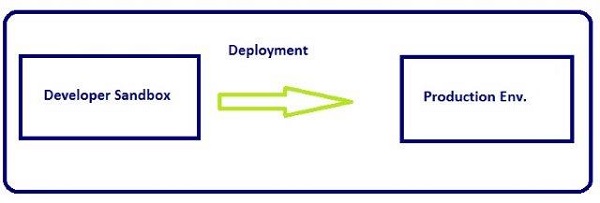
Steps to open Developer Console:
Step 1: Go to Name->Developer Console

Step2: Click on "Developer Console" and below window will appear.
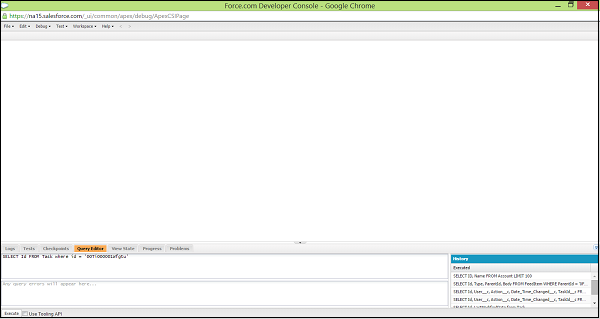
Below are some operations which you could perform using Developer Console.
Step 1: Login to the Salesforce.com using login.salesforce.com. Copy the code anippets mentioned in the tutorial. For now, we will use the following sample code:
 Step 2: To Open Developer Console click on Name -> Developer Console and then click on Execute Anonymous as shown below.
Step 2: To Open Developer Console click on Name -> Developer Console and then click on Execute Anonymous as shown below.

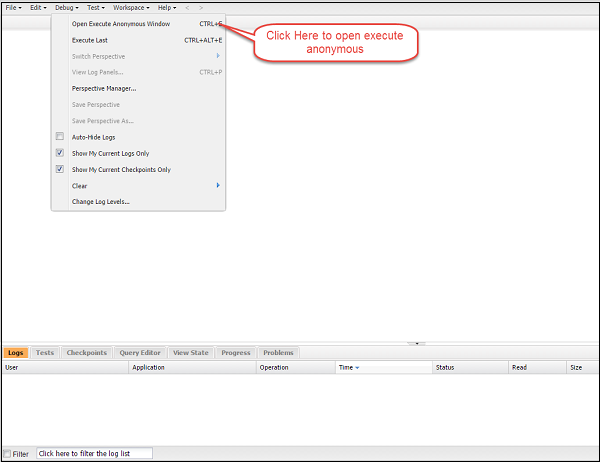
Step 3: Then a window will appear and you could paste code there.
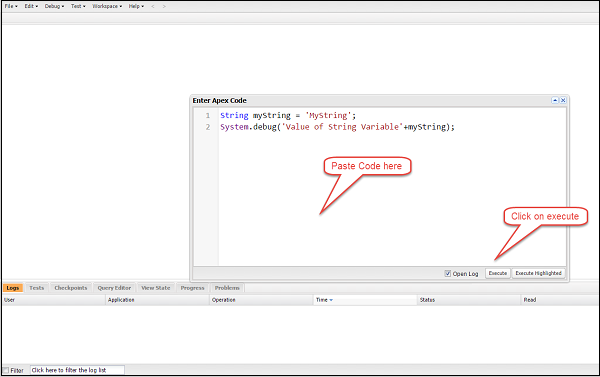
Step 4: Click on execute and then debug logs will open. Once the log appears in window as shown below then click on the log record:
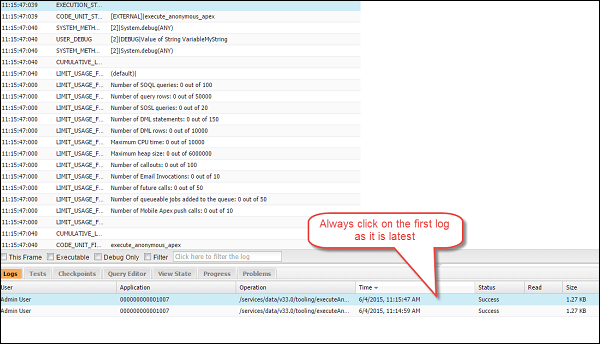
Then type 'USER' in the window as shown below and output statement will appear in debug window. This 'USER' statement is used for filtering the output.
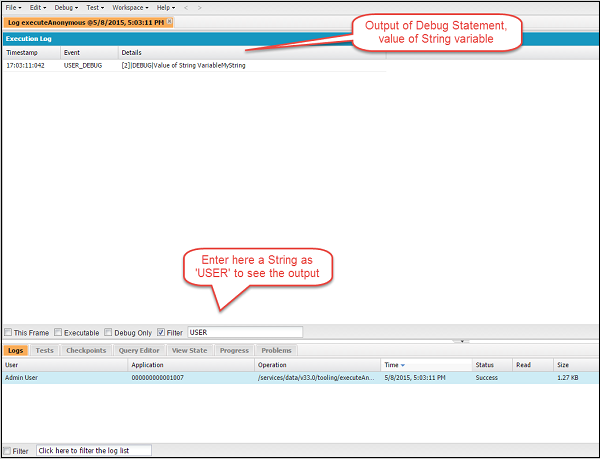
So basically, you will be following all the above mentioned steps to execute any code snippet in this tutorial.
You can develop the Apex code in either Sandbox or Developer edition of Salesforce. A Sandbox organization is a copy of your organization in which you could write code and test it without taking the risk of data modification or disturbing the normal functionality. As per the standard industrial practice, you have to develop the code in Sandbox and then deploy it to the Production environment.
For this tutorial, we will be using Developer edition of Salesforce. In Developer edition, you will not have the option of creating a Sandbox organization. The Sandbox features are available in other editions of Salesforce.

Apex Code Development Tools
In all the editions, we can use any of the following three tools to develop the code:- Force.com Developer Console
- Force.com IDE
- Code Editor in the Salesforce User Interface
Force.com Developer Console
The Developer Console is an integrated development environment with a collection of tools you can use to create, debug, and test applications in your Salesforce organization.Steps to open Developer Console:
Step 1: Go to Name->Developer Console

Step2: Click on "Developer Console" and below window will appear.

Below are some operations which you could perform using Developer Console.
- Writing and compiling code - you could write code using the source code editor. When you save a trigger or class, the code is automatically compiled. Any compilation errors will be reported.
- Debugging - you can view debug logs and set checkpoints that aid in debugging.
- Testing - you can execute tests of specific test classes or all classes in your organization, and you can view test results. Also, you can inspect code coverage.
- Checking performance - you can inspect debug logs to locate performance bottlenecks.
- SOQL queries - you can query data in your organization and view the results using the Query Editor.
- Color coding and autocomplete - the source code editor uses a color scheme for easier readability of code elements and provides auto completion for class and method names.
Executing Code in Developer Console
All the code snippets mentioned in this tutorial needs to be executed in developer console and below are the steps for the same.Step 1: Login to the Salesforce.com using login.salesforce.com. Copy the code anippets mentioned in the tutorial. For now, we will use the following sample code:
String myString = 'MyString'; System.debug('Value of String Variable'+myString);
 Step 2: To Open Developer Console click on Name -> Developer Console and then click on Execute Anonymous as shown below.
Step 2: To Open Developer Console click on Name -> Developer Console and then click on Execute Anonymous as shown below.


Step 3: Then a window will appear and you could paste code there.

Step 4: Click on execute and then debug logs will open. Once the log appears in window as shown below then click on the log record:

Then type 'USER' in the window as shown below and output statement will appear in debug window. This 'USER' statement is used for filtering the output.

So basically, you will be following all the above mentioned steps to execute any code snippet in this tutorial.

No comments:
Post a Comment